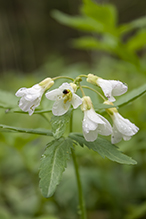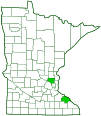abdominal short-winged flower beetle
(Heterhelus abdominalis)
Conservation • Description • Habitat • Ecology • Distribution • Taxonomy
Conservation Status |
|
|||||||
| IUCN Red List | not listed |
|||||||
| NatureServe | not listed |
|||||||
| Minnesota | not listed |
|||||||
Description |
||
Abdominal short-winged flower beetle is a small beetle. It occurs in the United States from New Hampshire and New York, south to Georgia, and west to Minnesota and Texas, and in southern Canada from Quebec to Manitoba. Though uncommon, it often occurs in large numbers. Adults are found in spring and summer, mostly on flowers, in a wide variety of habitats, including woodlands, wetlands, and semideserts. They are generalist feeders, feeding on the petals and pollen of a broad assortment of flowers. They are found on plants that host the larvae only during mating and egg laying. Larvae develop in seeds. Adults are 1⁄16″ to ⅛″ (2.0 to 3.0 mm) in length. The body is very compact, oval, and somewhat elongated when viewed from above, convex when viewed from the side. The head, the plate covering the thorax (pronotum), and the hardened wing covers (elytra) are deep metallic bluish-green, are distinctly pitted (punctate), and appear hairless. The head is horizontal, and the mouthparts are directed forward or nearly so (prognathous). It is only weakly constricted behind the eyes. There is no transverse ridge (occipital carina) at the back of the head. The compound eyes are moderately convex and are only weakly protruding. The jaws (mandibles) are short and sharp. They are not visible from above. The “under jaws” (maxillae) located behind the mandibles, have two lobes, the galea and the lacina. The antennae have eleven segments. They are pale and are weakly clubbed. The last three segments, which form the club, are dark and are enlarged but are not extended to one side. The pronotum is widest beyond the middle. The rear corners are angled inward. The rear margin is almost straight. The small plate between the wing bases (scutellum), is large, obvious, and curved. The elytra are short and do not completely cover the abdomen. They are not grooved. The exposed last two segments of the abdomen are reddish. The legs are robust and reddish. The fourth segment (tibia) of each leg has two spurs at the tip. The last part of each leg (tarsus), corresponding to the foot, has five segments. The claws at the end of each tarsus are simple, not split. |
||
Size |
||
Total length: 1⁄16″ to ⅛″ (2.0 to 3.0 mm) |
||
Similar Species |
||
Habitat |
||
A wide variety of habitats |
||
Ecology |
||
Season |
||
Spring and summer |
||
Behavior |
||
Adults are active fliers |
||
Life Cycle |
||
|
||
Larva Food |
||
Seeds |
||
Adult Food |
||
Flower petals and pollen |
||
Distribution |
||||
|
Sources |
|||
| 5/15/2023 | ||||
Occurrence |
||||
Uncommon |
||||
Taxonomy |
|||
Order |
Coleoptera (Beetles) | ||
Suborder |
Polyphaga (Water, Rove, Scarab, Long-horned, Leaf, and Snout Beetles) | ||
Infraorder |
Cucujiformia | ||
Superfamily |
Cucujoidea (sap, bark, and fungus beetles) | ||
Family |
Kateretidae (short-winged flower beetles) | ||
Genus |
Heterhelus | ||
Family Genus |
|||
Synonyms |
|||
Boreades abdominalis Cercus abdominalis |
|||
Common Names |
|||
abdominal short-winged flower beetle |
|||
Glossary
Elytra
The hardened or leathery forewings of beetles used to protect the fragile hindwings, which are used for flying. Singular: elytron.
Maxillae
Paired mouth structures of arthropods located immediately behind the mandible and used for tasting and manipulating food. “Under-jaws”.
Occiput
The back of the head. In Odonata, Megaloptera, and Neuroptera, the upper part of the head behind the eyes.
Pronotum
The exoskeletal plate on the upper side of the first segment of the thorax of an insect.
Punctate
Dotted with pits (punctures), translucent sunken glands, or colored spots of pigment.
Scutellum
The exoskeletal plate covering the rearward (posterior) part of the middle segment of the thorax in some insects. In Coleoptera, Hemiptera, and Homoptera, the dorsal, often triangular plate behind the pronotum and between the bases of the front wings. In Diptera, the exoskeletal plate between the abdomen and the thorax.
Tarsus
On insects, the last two to five subdivisions of the leg, attached to the tibia; the foot. On spiders, the last segment of the leg. Plural: tarsi.
Tibia
The fourth segment of an insect leg, after the femur and before the tarsus (foot). The fifth segment of a spider leg or palp. Plural: tibiae.
Visitor Photos |
|||||
Share your photo of this insect. |
|||||
| This button not working for you? Simply email us at info@MinnesotaSeasons.com. Attach one or more photos and, if you like, a caption. |
|||||
Greg Watson |
|||||
 |
|||||
MinnesotaSeasons.com Photos |
|||||
|
|||||

Slideshows |
||

Visitor Videos |
|||
Share your video of this insect. |
|||
| This button not working for you? Simply email us at info@MinnesotaSeasons.com. Attach a video, a YouTube link, or a cloud storage link. |
|||
Other Videos |
|||

Created: 5/15/2023
Last Updated:


